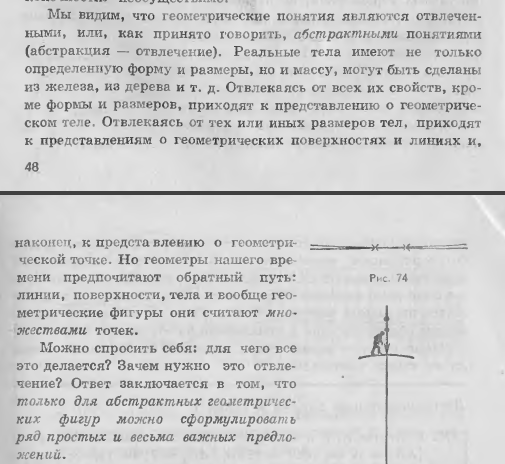What is an event, or why 4-D geometry for business analytics?
Petka, how? Passed the exam?
No, Vasily Ivanovich! I was asked to square the trimesh decompose. And I’m not just decomposing it, I can’t imagine it!

Statement of a question
When modeling the domain and describing the implementation, we often use the term event . However, as far as I know, few people understand the meaning of this term and can clearly give a definition of this term. In addition, an event is often confused, an event type, and an event class.
Look at the chart. Something is depicted on it in circles. In BPMN notation, this is something called an “Event.” But what is the event itself? And why is the operation of sending a message in one case designated as an event, and in the other as an operation?
')

What I did not like ISO 15926
In past articles, I gave definitions of a physical object.
A physical object is any subset of 4-D space-time.
In addition, I gave definitions of functional and informational objects.
Physical and informational objects are physical objects in 4-D space-time that, from the observer’s point of view, perform certain functions or serve specific purposes.
For example, a physical object of a piece of iron that exists in space-time can serve as a mount for one subject, a screwdriver for another, a hammer for a third, and a symbol of liberation from slavery for a fourth. I also noted that the object and the operation are the same in terms of space-time. This equality allows us to describe operations as 4-D space-time objects. I borrowed this conclusion from ISO 15926, intended to describe the production processes of the oil and gas industry. However, those who participated in the development of the standard, grabbed half the idea, but did not catch the second half.

The figure shows the entire space – time. Any subset of this space - there is a 4-D physical object (piece of iron), which in turn, in the eyes of the subjects can perform many functions (nail puller, hammer, scrap), or be the functions themselves: tear the nail, trim the hood and so on.
But they could not understand that a physical 4-D object can also be a physical event, which can be interpreted differently by different subjects, that is, a physical object is a physical event, which, in turn, is associated with many functional events.

For example, the 4-D object “Battle of Kulikovo” can be considered as a physical event with which two functional events are connected: victory and defeat. That is, one physical object (many sweaty bodies in one place), which the narrator describes as a functional event (victory or defeat depending on the preferences of the narrator).
In ISO 159126, an event is a 3-D object, a kind of abstraction that can be imagined as frozen time. The misinterpretation of this term in ISO 15926 has given rise to many problems. For example, the inability to use the standard in other areas of knowledge, for example, in describing the activity of the enterprise.
In this article I will describe in detail the meaning of the term event in terms of 4-D space-time.
I emphasize that I use the term activity, and not activity, as they say now. The term activity refers to the mental functions of a person and has nothing to do with the description of the activity of objects, including enterprises.
Lyrical digression
My father is a mathematician. But not a simple mathematician, but enthusiastic (as if there are others). When I built the calculus system with base 7, just because I did not like base 10, he told me about base 2 and how this base is used in computational mathematics. I did not like base 2 for another reason, but I was surprised by the idea of multiplying by shift of a register. He also taught me how to retrieve the root column. But it was here that bad luck happened. The number of digits as a result of extracting the root was infinite, which I could not understand or allow. I could not imagine a universe that is so unthinkably arranged. Even negative numbers went smoothly (forward and backward directions), but endless fractions did not. I was asked not to bathe and imagine infinity, which is why I finally fell into despair. If mathematicians work with such an object that I cannot even imagine, then what can I do at all ?! My dream will remain a dream, and work for me as a shovel operator. Only much later, after reading the stories about how Cantor and Dedekind suffered over an attempt to explain the irrational numbers, did I understand that this task was not an easy one. I also realized that mathematicians consider irrational numbers as an abstraction, devoid of meaning. They are only a tool in the hands of mathematicians in order to justify quite reasonable things. So, I realized that infinite fractions in nature does not exist, and therefore there are no points. This thought was confirmed by Kolmogorov, whose textbook on geometry I read at school several times. In the 10th grade, the school forced us to conduct a comparative analysis of the Kolmogorov Textbook and the Pogorelov textbook. Then, by the way, for the first time I was able to compare what a textbook and a Textbook are. Here is a quote from the textbook of Kolmogorov, which put everything in its place:
Everything fell clear. Bodies do not consist of points, and points are just an abstraction. And all the talk about the fact that the world consists of countless points is meaningless. Knowing this is useful to us in order to introduce the concept of an event.
Everything fell clear. Bodies do not consist of points, and points are just an abstraction. And all the talk about the fact that the world consists of countless points is meaningless. Knowing this is useful to us in order to introduce the concept of an event.
Point of view of philosophers
Many philosophers say this: there are three-dimensional objects and their properties. And, that three-dimensional objects show their properties only in time. That is, time is the ability of three-dimensional objects to express themselves. Here is the picture:
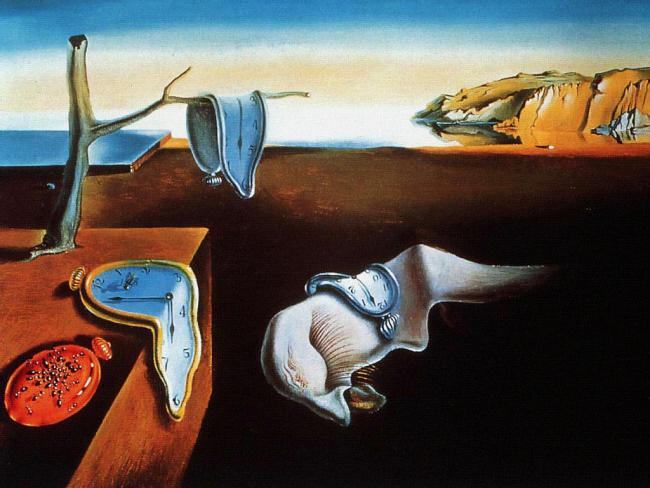
Try to analyze it as you analyze any other subject area. It will not work, because the property of an object to manifest itself in time is a description of our mental experience of being. To describe things in terms of our experiences is the task of the humanities. The task of engineers is to create a model of reality that can be used with a practical purpose - building models of certain subject areas (enterprises, technological processes, and so on).
Thought experiment
Let's put a mental experiment. Imagine the usual three-dimensional space. But now let us move in this space along the x axis and let there be a small feature - all that we know is only what is behind us, and what lies ahead is covered with uncertainty. And the only way to know what lies ahead is to move forward. But back with this we can not move. Here is a two-dimensional model of space-time. The only difference between x coordinates and other coordinates is that we move along it only in one direction. You can practice your rhetoric on this model. It will be exactly like our rhetoric, but now flat figures will show their properties in the process of movement along the x axis. Because of our psychic experiences, we separated this coordinate separately from others and decided that this is exactly what exists. However, things are not aware of our mental experiences. And it is clear that movement along one of the axes is only our way of talking about our perception of the world.
Once again about ISO 15926
Let's change our attitude to time and equate it to the rest of the coordinates. This point of view will allow us to handle four-dimensional objects as we handle three-dimensional objects. This will allow to apply the theory of sets to objects of the real world and, as a result, to solve a quite pragmatic task - to describe the enterprise architecture and to set up planning and accounting without the special crutches to which we are now forced to resort. One of these crutches is the forced confidence of many analysts that there is a correct point of view and the rest. This confidence is taken from the fact that it is difficult for the analyst to describe various projections of 4-dimensional objects on three-dimensional planes in terms of mental experiences. Even, I would say, it is impossible, because for this it is necessary to have not a long imagination. I tried to do it - not an easy task! However, having accepted the existence of 4-D space, everything is greatly simplified.
This is exactly what the developers of the ISO 15926 standard did. This standard shows how important it is to be able to adopt an optimal point of view on the areas under study. One does not fit, you can apply another. In terms of 4-dimensional space-time, the problem to be solved becomes clear, and the limitations of this problem are clear. The task is to design the 4-D objects required by the customer. And the limitations of the task are the presence of the model itself.
Model limitations
The fact is that we proceed from the fact that the model of being is the very being. For example, you have your own image in your head. And you call this image of yourself. For example, the words “I would never do that,” actually mean: “In my model, I myself have no such property as the ability to perform such actions.” If you change the installation, then the impossible becomes possible (remember the film "Fight Club"). Your self-image and you are not the same. See how you build the event model. An event occurs, then we perceive it, then we process the results of perception, then using a certain paradigm, we build a model of this event. From the moment an event takes place until the moment when its model is built, a huge period of time passes. After this time, we can begin to say that something happened. And we are not talking about the event, we are talking about the model of this event. Our reactions are very late as a result. Those who are engaged in martial arts, know that in a real battle there is no place for modeling, there is a presence in a certain stream and following this stream. However, someone who says that modeling is not necessary, is also mistaken. Only by spending enormous efforts on modeling, we are able to be spontaneous. (This is our nature). Therefore, we continue to model again and again, so that at one point we can deviate from the plan and allow ourselves to improvise.
Ways to describe three-dimensional objects and their meaning.
How do we describe three-dimensional objects? There are many ways to describe it. Without proof and explanation, here is a picture:
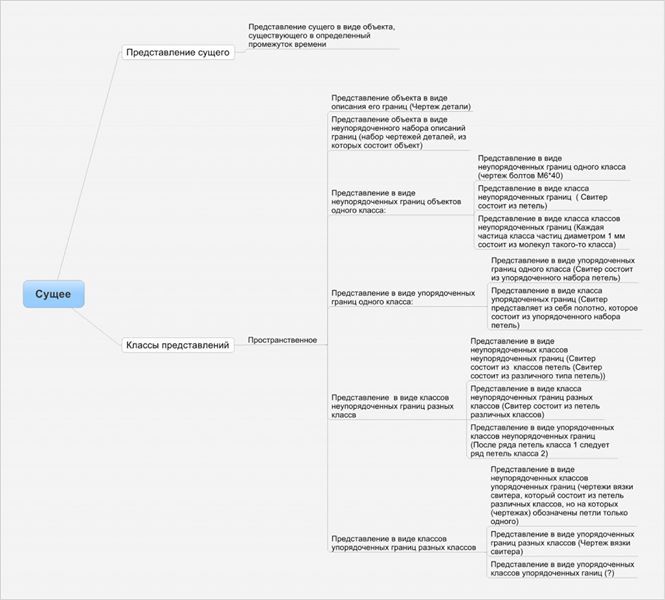
We use surfaces to support the description of three-dimensional objects. This is what we can imagine, because our senses are capable of perceiving surfaces, but not volumes. (Talking on this topic is a separate task). How do we imagine the surface? Like a surface that separates two different environments. For example, the plane of the pyramid is the surface that separates the stone and the air. And here we are confronted with a generalization - the surface is uneven, having a sufficiently large thickness. And yet, we are talking about the plane. Because for our purposes we can neglect the irregularities and thickness. Exactly, as Kolmogorov said (see Lyrical digression). Of course, this does not mean that we will do it now forever. At the right moment, we detail our understanding of the plane of the pyramid. So, the surface can be considered a certain volume of space (object), which from the point of view of modeling can be imagined as an object that does not have thickness. What is a line? Line can be called the intersection of surfaces. Thus, the line is a certain volume of space (object), which from the point of view of modeling does not have width and height, but only has length. Well, and then the point is an object, the dimensions of which can be neglected from the point of view of modeling. For example, a point is the intersection of several planes - the top of a pyramid. It is clear that the top has a certain volume, but for the purpose of modeling we have neglected this volume.
Joke
You can afford imagination, and instead of volume, introduce the concept of the probability of the location of a vertex at a specified point in space. Then, instead of the volume occupied by the vertex, we obtain the probability distribution of the position of the vertex in space, depending on the observer who made the measurement. Nothing like? Quantum uncertainty principle, no? Is it possible that the particles we observe are nothing more than intersections of planes?
Event definition
Consider the top of the pyramid in terms of 4-d space-time. In this space, the top of the pyramid exists not only in space, but also in time. In time, the top is a line. Therefore, what we used to call a point is a line in 4-D space-time! This line is the trajectory of the vertex. Thus, the first find we found in 4-D space-time was the trajectory!
The edge of the pyramid is a three-dimensional volume in space-time. And the pyramid itself is a four-dimensional volume in space-time. This position will allow us to introduce a definition of the concept of an event.
Let us proceed by analogy with geometric constructions. Point, plane, line - these are objects that have dimensions from the point of view of the observer are negligible to mention them. If we take the time axis and cut a section on it so large that its size can be neglected, then where does it go? We chose a delta t on the time axis, within which the position of the bodies changed very little. They took such a body and said that at such and such a period of time the body was approximately here. For example, at 10-00 the descent vehicle crossed the border of dense layers of the atmosphere (dot 1 in the figure).
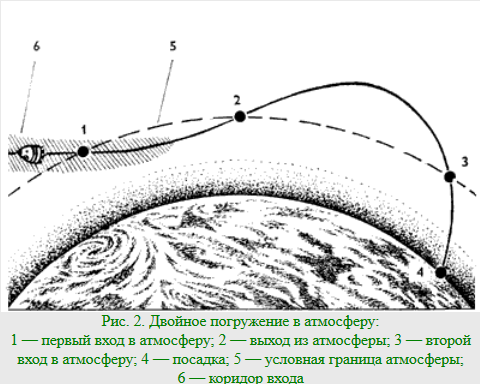
It is clear that the border also exists as a rather thick formation, the thickness of which we have neglected. It is clear that the moment the apparatus enters the dense layer is a rather long process. However, from the point of view of modeling, it was a brief moment and a fine line. As a result, such a construction was called an event.
We give the definition of the term event by analogy with the terms point, plane and straight line.
An event is an object in 4-D space-time, whose temporal dimensions can be neglected from the point of view of modeling.
Construct a space-time diagram. Suppose there are three coordinates that are merged into one vertical axis in the diagram. And let there be a time coordinate, which is the horizontal axis. Then an object in space-time can be represented as follows:
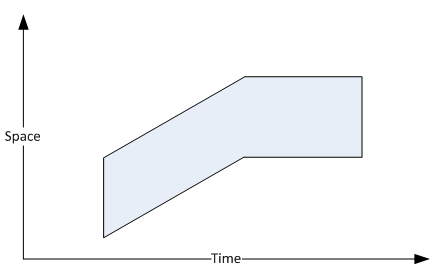
An event on such a chart can be represented as:
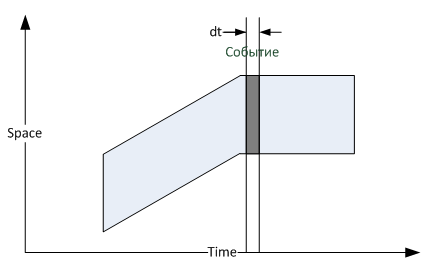
Event can be a geometric point? No, a point is a long line in time. However, if a point existed very little in time from the point of view of modeling, then it becomes an event - a point. For example, at 12-00 a supernova broke out in the constellation Sagittarius. Flashed - a brief moment in time, a supernova from such a distance - this is a point in space. Thus, a flash of a supernova can be considered a point event.

Event - direct and event - make a plane yourself. But the volume event is what we work with all the time. For example, the Battle of Kulikovo. This event from the point of view of the student occurred in space - on the Kulikovo field.
If the points in the geometry are needed to build lines, planes and volumes, then events are needed to build trajectories, a description of the format of the video recording, a description of the activities of the enterprise. The equalization of the time axis and spatial coordinates leads us to what we were looking for. We were able to describe events in the same way that we describe the geometric parameters of objects.
Details
If a pyramid is what exists in 4-D space-time, and a volcanic eruption is also something that exists in 4-D space-time, if the top has a trajectory just like a stone thrown by a volcano, then in terms of space-time, these objects belong to the same class. Thus, it can be argued that the object and the incident are the same thing - 4-D objects. That is, using a unified approach, it is now safe to say that the door handle is activity from some point of view, and the production operation is an object from some point of view. Here it is necessary to shut up and realize what is happening.
Events as a way to describe an object.
We apply the event definition to describe the object in time. To do this, the object is divided into states and events. In this case, intuitively, we understand that a state is something that lasts a long time, and it is stable, and an event is something that occurs instantaneously. As a result, the object is represented as a series of states separated by events. Let's try to apply this principle to the description of the lighthouse. And we will prove that the division into events and states is entirely arbitrary, it depends only on the preferences of the author of such a division.

So, let us have a beacon, to create a beam which uses a regular fire. At the same time, in order to create the flickering of this lighthouse, the engineers did not invent anything better than to make the lighthouse keepers start and put out the fire continuously. That is, as soon as the caretaker started the fire, as soon as the fire started burning, you should immediately start extinguishing it: haul buckets of water and pour coal. Just poured the coals, you should immediately begin to dry them, inflate and re-ignite. Here is a continuous production cycle. Let's see how it can be modeled.
Let the brightness of the fire change according to the law presented on the graph:
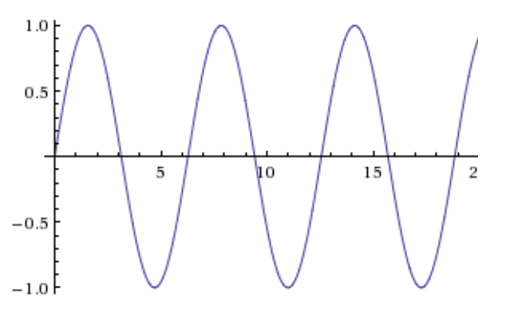
Let's imagine the looker on a ship that reports the situation to the captain. His rhetoric is as follows: on the right of two points of view I see a lighthouse. He does not say that the lighthouse changes its state, no. He speaks as if the lighthouse does not change its state. Because at the moment there is no need for such a degree of detail. However, when a sailor must be convinced that a lighthouse is in front of him, and not a random glint, he must check that the lighthouse is flickering. And then he said to himself: extinguished, flared, extinguished ... yeah, it means a lighthouse. Here is the question, what is flared, extinguished, and what is in between? Flashed - this is from the point of view of the sailor event, which means that the lighthouse came on. But he didn’t light up instantly, although the sailor just imagined himself so - he lit instantly. In fact, lit up - this is a length of time, and extinguished - this is also a period of time. On the chart, you can see it like this:

So, the description of the lighthouse in the sailor’s head looks like this: the state of the lighthouse: glows and does not glow. The events that need to be registered are a beacon that has flashed and the beacon has gone out.
Now let's pay attention to how the ranger sees the state of the lighthouse. He has two tasks - to extinguish and kindle. These are the two states in which it is located. There are two events between them - the transition from the ignition state to the extinguishing state and from the extinguishing state to the ignition state. On a temporary map, this can be represented as:
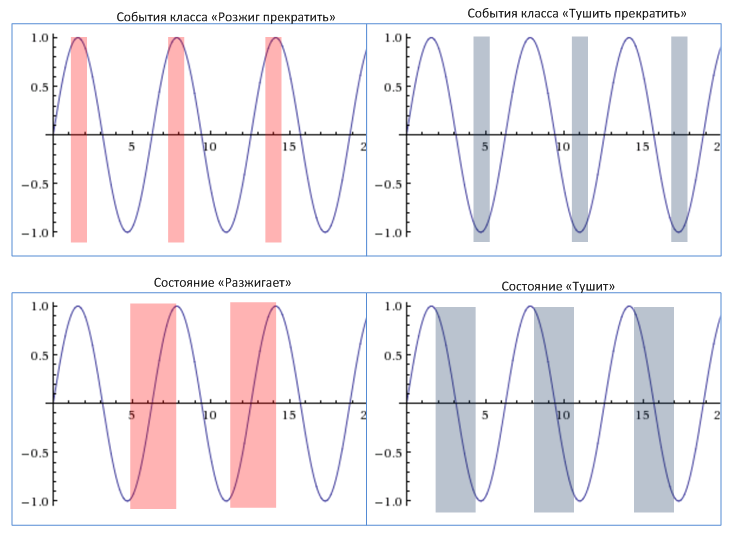
It can be seen from the graphs that what in the first case (from the point of view of the seaman) was a state, in the second (from the point of view of the caretaker) became an event and vice versa - what was in the first case (from the point of view of the seaman) was an event, in the second (from the point of view of the caretaker) has become a state.
Thus, the same object can be described in completely different ways, breaking it up into different temporary parts. It turned out that the same temporary part of the object (which is also an object by definition) can be both an event and a state depending on the point of view. This confirms our conjecture that an event is a 4-D object, which, from the observer’s point of view, has zero width in time. At the same time we received a free definition of the state.
A state is a temporary part of an object, from the observer’s point of view unchanged throughout its duration. A distinctive feature of the state is its length in time.
What remains unchanged in the state of the lighthouse "A fire is kindling" - the kindling of a fire remains unchanged from the point of view of the observer.
We have shown that to describe an object in time, we use the method of splitting this object into temporary parts, some of which, from the observer’s point of view, are considered to be zero width in time (events), and some are non-zero (states). The lighthouse from the point of view of the observer is described as follows:

Conclusion
It should be noted that the lighthouse is divided into parts connected with each other. But there are such objects that may not have a connection in space-time. For example, let there be a school number 134. At first it was built on one place, then destroyed and built on another.
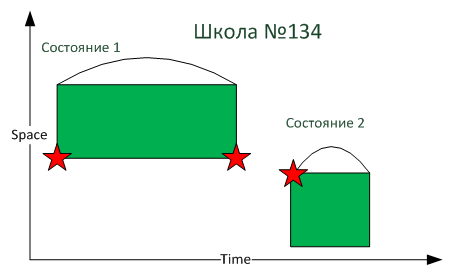
Thus, an object can also be an unrelated set in 4-D space.
Events play an important role in the description of objects. In the following articles we will discuss this topic in more detail. We will study the functional events and then see how the events are used in the description of the enterprise activity. And also talk about the classes of events.
Source: https://habr.com/ru/post/246991/
All Articles
